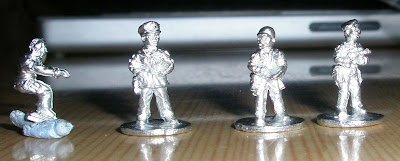I've recently been reading a lot of
Kim Newman's older short stories in the collections
The Original Dr. Shade

and
Famous Monsters
. This has been interesting to see the evolution of his writing style as many of the stories in the Original Dr. Shade are very early pieces where the use of pop culture references, particularly to film is not as developed as in his more recent work.
Doctor Shade features a number of Newman's recurring characters including the sinister figure of media mogul Derek Leech. Though funnily enough the figure that Leech seems closest to in real life has actually changed from its original target in my opinion, though others may not agree with my
expression of it.
My favourites stories in
The Original Dr. Shade are the title story, which is an interesting riff on an apparently fictional character emerging into the real world; G
argantuabots versus the Nice Mice, satirising the toy industry and its 'hot toys';
D-and-D and
The man who collected Barker.
D-and-D is one of the first times I've seen the fantasy Vietnam scenario used in wide circulation, though we did have
A Private Hell in the
Dungeoneer from 1979 as the first time I saw Vietnam era US soldiers trapped in a fantasy world. Newman makes good use of the alternative reality scenario with dwarves and other creatures allied to the human forces.
Generally the stories in
Famous Monsters show the development of Newman's writing style and it includes alternative histories as well as horror stories. There are a lot of stories including one of Newman's favourite tropes of mixing historical figures with existing fictional characters, both his and other authors. An example of this is
The Big Fish, a Cthulhu Mythos story where Geneviève Dieudonné from Jack Yeovil's Warhammer stories appears.
The Big Fish is a nicely written piece that works by conflating the horror and detective story genres. Some of the stories are a bit dated such as
Pitbull Brittain which is very much of the Thatcher government era and I think might be hard to understand for a reader that, unlike me, couldn't remember the era.
There is an interesting rework of the Zorro legend in
Out of the Night and I'd say that is another of my favourite stories from
Famous Monsters using a werewolf trope and a finale in contemporary Los Angeles.
I'm probably going to return to writing some more about Kim Newman and his associate Jack Yeovil's fiction in the near future.















